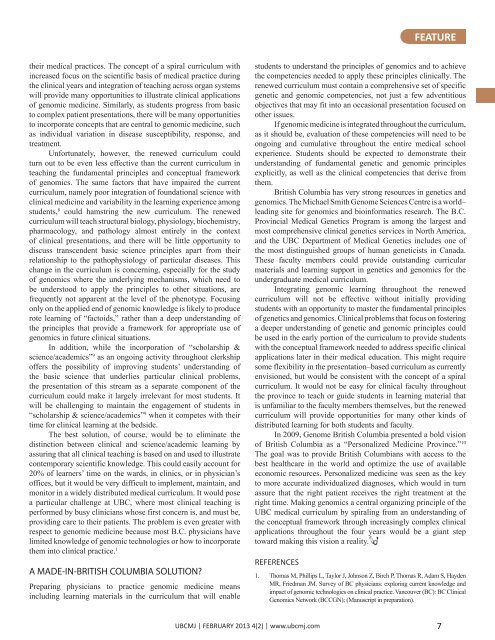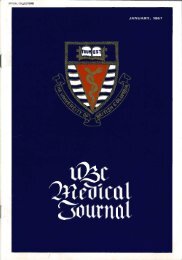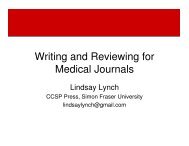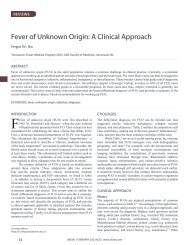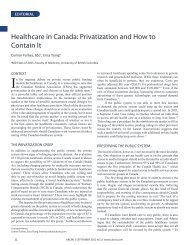Download full PDF - UBC Medical Journal
Download full PDF - UBC Medical Journal
Download full PDF - UBC Medical Journal
You also want an ePaper? Increase the reach of your titles
YUMPU automatically turns print PDFs into web optimized ePapers that Google loves.
FEATURE<br />
their medical practices. The concept of a spiral curriculum with<br />
increased focus on the scientific basis of medical practice during<br />
the clinical years and integration of teaching across organ systems<br />
will provide many opportunities to illustrate clinical applications<br />
of genomic medicine. Similarly, as students progress from basic<br />
to complex patient presentations, there will be many opportunities<br />
to incorporate concepts that are central to genomic medicine, such<br />
as individual variation in disease susceptibility, response, and<br />
treatment.<br />
Unfortunately, however, the renewed curriculum could<br />
turn out to be even less effective than the current curriculum in<br />
teaching the fundamental principles and conceptual framework<br />
of genomics. The same factors that have impaired the current<br />
curriculum, namely poor integration of foundational science with<br />
clinical medicine and variability in the learning experience among<br />
students, 8 could hamstring the new curriculum. The renewed<br />
curriculum will teach structural biology, physiology, biochemistry,<br />
pharmacology, and pathology almost entirely in the context<br />
of clinical presentations, and there will be little opportunity to<br />
discuss transcendent basic science principles apart from their<br />
relationship to the pathophysiology of particular diseases. This<br />
change in the curriculum is concerning, especially for the study<br />
of genomics where the underlying mechanisms, which need to<br />
be understood to apply the principles to other situations, are<br />
frequently not apparent at the level of the phenotype. Focusing<br />
only on the applied end of genomic knowledge is likely to produce<br />
rote learning of “factoids,” rather than a deep understanding of<br />
the principles that provide a framework for appropriate use of<br />
genomics in future clinical situations.<br />
In addition, while the incorporation of “scholarship &<br />
science/academics” 9 as an ongoing activity throughout clerkship<br />
offers the possibility of improving students’ understanding of<br />
the basic science that underlies particular clinical problems,<br />
the presentation of this stream as a separate component of the<br />
curriculum could make it largely irrelevant for most students. It<br />
will be challenging to maintain the engagement of students in<br />
“scholarship & science/academics” 9 when it competes with their<br />
time for clinical learning at the bedside.<br />
The best solution, of course, would be to eliminate the<br />
distinction between clinical and science/academic learning by<br />
assuring that all clinical teaching is based on and used to illustrate<br />
contemporary scientific knowledge. This could easily account for<br />
20% of learners’ time on the wards, in clinics, or in physician’s<br />
offices, but it would be very difficult to implement, maintain, and<br />
monitor in a widely distributed medical curriculum. It would pose<br />
a particular challenge at <strong>UBC</strong>, where most clinical teaching is<br />
performed by busy clinicians whose first concern is, and must be,<br />
providing care to their patients. The problem is even greater with<br />
respect to genomic medicine because most B.C. physicians have<br />
limited knowledge of genomic technologies or how to incorporate<br />
them into clinical practice. 1<br />
A MADE-IN-BRITISH COLUMBIA SOLUTION<br />
Preparing physicians to practice genomic medicine means<br />
including learning materials in the curriculum that will enable<br />
students to understand the principles of genomics and to achieve<br />
the competencies needed to apply these principles clinically. The<br />
renewed curriculum must contain a comprehensive set of specific<br />
genetic and genomic competencies, not just a few adventitious<br />
objectives that may fit into an occasional presentation focused on<br />
other issues.<br />
If genomic medicine is integrated throughout the curriculum,<br />
as it should be, evaluation of these competencies will need to be<br />
ongoing and cumulative throughout the entire medical school<br />
experience. Students should be expected to demonstrate their<br />
understanding of fundamental genetic and genomic principles<br />
explicitly, as well as the clinical competencies that derive from<br />
them.<br />
British Columbia has very strong resources in genetics and<br />
genomics. The Michael Smith Genome Sciences Centre is a world–<br />
leading site for genomics and bioinformatics research. The B.C.<br />
Provincial <strong>Medical</strong> Genetics Program is among the largest and<br />
most comprehensive clinical genetics services in North America,<br />
and the <strong>UBC</strong> Department of <strong>Medical</strong> Genetics includes one of<br />
the most distinguished groups of human geneticists in Canada.<br />
These faculty members could provide outstanding curricular<br />
materials and learning support in genetics and genomics for the<br />
undergraduate medical curriculum.<br />
Integrating genomic learning throughout the renewed<br />
curriculum will not be effective without initially providing<br />
students with an opportunity to master the fundamental principles<br />
of genetics and genomics. Clinical problems that focus on fostering<br />
a deeper understanding of genetic and genomic principles could<br />
be used in the early portion of the curriculum to provide students<br />
with the conceptual framework needed to address specific clinical<br />
applications later in their medical education. This might require<br />
some flexibility in the presentation–based curriculum as currently<br />
envisioned, but would be consistent with the concept of a spiral<br />
curriculum. It would not be easy for clinical faculty throughout<br />
the province to teach or guide students in learning material that<br />
is unfamiliar to the faculty members themselves, but the renewed<br />
curriculum will provide opportunities for many other kinds of<br />
distributed learning for both students and faculty.<br />
In 2009, Genome British Columbia presented a bold vision<br />
of British Columbia as a “Personalized Medicine Province.” 10<br />
The goal was to provide British Columbians with access to the<br />
best healthcare in the world and optimize the use of available<br />
economic resources. Personalized medicine was seen as the key<br />
to more accurate individualized diagnoses, which would in turn<br />
assure that the right patient receives the right treatment at the<br />
right time. Making genomics a central organizing principle of the<br />
<strong>UBC</strong> medical curriculum by spiraling from an understanding of<br />
the conceptual framework through increasingly complex clinical<br />
applications throughout the four years would be a giant step<br />
toward making this vision a reality.<br />
REFERENCES<br />
1. Thomas M, Phillips L, Taylor J, Johnson Z, Birch P, Thomas R, Adam S, Hayden<br />
MR, Friedman JM. Survey of BC physicians: exploring current knowledge and<br />
impact of genomic technologies on clinical practice. Vancouver (BC): BC Clinical<br />
Genomics Network (BCCGN); (Manuscript in preparation).<br />
<strong>UBC</strong>MJ | FEBRUARY 2013 4(2) | www.ubcmj.com<br />
7


